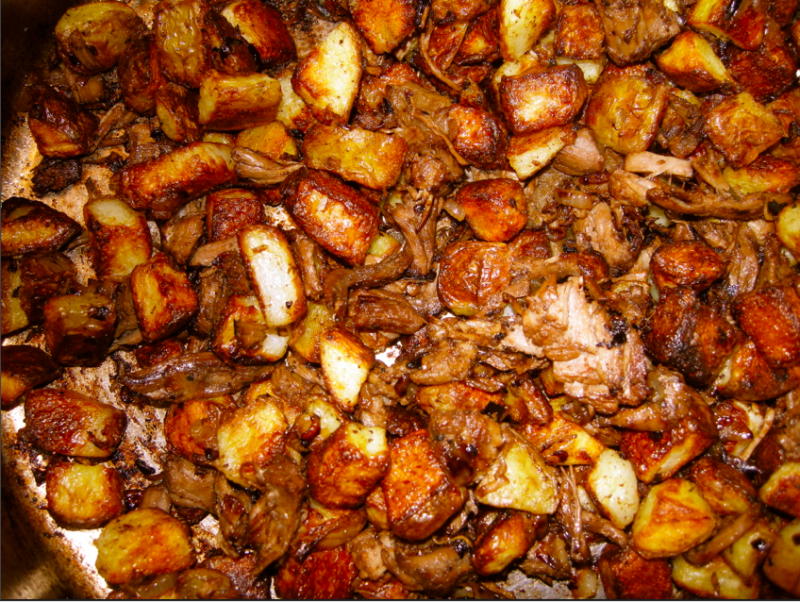-
Posts
7,674 -
Joined
Content Type
Profiles
Forums
Store
Help Articles
Everything posted by Mjx
-
The oil in the vinaigrette will begin breaking down the waxy cuticle/cell walls almost immediately, so, depending on precisely what is in the salad (i.e. tender v. more robust greens), the greens in particular will often show visible signs of wilting within 15 minutes.
-
Actually, ha-la-PEH-nyo; the letter 'e' is never pronounced as an 'ee' in Spanish (for that, they use the letter 'i').
-
Really sorry to hear about this. Is the advice to replace because of some form of chemical contamination, or just odour?
-
I toss some konjaku powder into hot coffee/chocolate/mocha (occasionally, lemonade or tea), then shove it in the fridge for half an hour. Love the stuff, and it sets up much more quickly than gelatine.
-
I know, but it would sidestep/solve potential problems (and unless US ricotta is a different substance then the one I know, it isn't generally a lump..?). And to be clear, I agree with the premise that if you're eating as part of a group, you partake of (or not) the things on the table; it's about the group and its needs, which trump individual needs. And I'm saying this as someone who has a couple of food sensitivities (not allergies, but they're real, unfortunately: they visibly attack my joints and mucous membranes, visibly and within minutes), and has some distinct and visceral dislikes. But if I'm eating with a group, I shut up about these things, and deal, quietly. If there's nothing I can actually eat, well, too goddamn bad; if I have to eat something to be polite, I can usually manage to keep it down. I can't say I've ever felt marginalized by this sort of situation. On the other hand, none of this is going to help jrshaul come up with fabu solutions for meals at USD0.50/head, so...
-
That looks really good. And very similar to a dish I often make. But you do realize, of course, that all of the various 'No Dairy' factions wouldn't touch it. No reason the dairy items couldn't be served on the side; it kind of makes sense anyway, and besides, people usually enjoy doing a little low-end customizing of their food. Not to mention, on a table with not much on it, dishes of cheese and so on fill up a bit of the empty real estate.
-
Well, here's mine: Objectively, I'd have to say the picture is not that appetizing (you should see the raw image), but the dish was actually quite tasty. We don't tend to have much in the way of leftovers, so this was a combination of a single portion of a supposedly Spanish-inspired beef stew from the January/February issue of Cook's Illustrated, combined with a half-portion of a home fry recipe from the same issue. My idea was to do something along the lines of biksemad (which Mette mentioned, upthread), but I ran out of steam when the time came to turn the beef chunks into small dice, and I just broke/shredded them up, instead. The potatoes were crisp and caramelized on the outside, fluffy within, and the meat was moist and tender. Apparently, ketchup and HP Sauce are standard with biksemad, so my boyfriend set up small ponds of each at the edge of his plate. We had rucola with this, too. But, does this count as hash, or did the inclusion of home fries kind of blow this out of the water?
-
Actually, lighter roasts have more caffeine, because some of the caffeine is broken down by the roasting process, or so I have read. And a truly "blonde roast" wouldn't even really be "done", I wouldn't think. If you are not through first crack, it's not really roasted, and in my roasting experience, if you are past first crack, it's more brunette than blonde... No interest in trying this one. I've read that too. But I was thinking in terms of flavour, actually: The first thing to hit you with a dark roast (first sip, even before the caffeine manifests) is the assertive, eye-opening flavour, which seems sort of intrinsic to drinking coffee... 'mellow' and gentle' just seem misplaced/pointless (but I've been drinking espresse since I was two or three, so this obviously biases my view).
-
But... that somehow makes the whole 'two-in-one' thing entirely superfluous. ...on the other hand, there is that.
-
I think court bouillon is used to poach fish, but not made from fish. Hm. For whatever reason, I just assumed it was made from fish/seafood, too.
-
This doesn't mesh with my experience at all; I've eaten fish (mostly trout, and some perch) caught directly from the river, and they've always tasted clean and fantastic. I've never quite seen the point of court bouillon, but these fish would probably make fine versions of it, for... whatever it's used for. You were probably not brought up on ocean fish like me. Seems like most others had different experiences to you as well. Would the character of the stream bed affect the flavour of the fish living in it? The fish I had came from a (mostly swiftly flowing) stream/river that was rocky/pebbly over the length of most of its bed.
-
This doesn't mesh with my experience at all; I've eaten fish (mostly trout, and some perch) caught directly from the river, and they've always tasted clean and fantastic. I've never quite seen the point of court bouillon, but these fish would probably make fine versions of it, for... whatever it's used for.
-
The venison en croute looks looks beautiful! If you want the pastry a bit more 'done' next time, you might want to give this a go (method I use for this same dish, I have no sous-vide setup): Take the (raw) venison directly from the refrigerator, and sear it at very high temp., just to colour it, then wrap it in the pastry, and bake it briefly in a very hot oven. The venison I get is (mostly) from roe deer, so the pieces are quite small in cross-section, but using this method, it's still possible to serve it rare.
-
Eeeh, you may have a point, and this may be my only option, although I haven't entirely given up on finding another source/option.
-
Actually, it is possible to treat the exterior of each piece before tying them together. Unfortunately, the work that describes this (Guess What Came to Dinner, by Gittelman), is in a moving box, and I can't lay hands on it. Possibly someone else has it? You soak the meat in water to which a small but effective quantity of chlorine has been added; what I cannot remember is how much bleach per volume of water, and how long it needs to be soaked.
-
Thanks, but as I said, I don't want to get a whole bale-ful of them, just a few (which I was able to do in Italy), since I use them fairly seldom (and I hate waste, so throwing the excess out isn't an option). If all else fails though, I guess I'll have to see whether can club together with a few other Italians I know in DK, and go that route.
-
Interesting, I didn't know that they were used in Norwegian sweets, too. I could go round to the Catholic church (yes, I'm still in Denmark, and there aren't so many Catholic churches here), but I feel a bit shy about doing that. I agree, the rice paper doesn't seem like it would quite work out. Maybe I could find shop that stocks Norwegian ingredients, in Copenhagen. I need to check the Asian shops; I haven't seen the sort of rice paper you describe, just what's used for spring rolls, and that just doesn't seem to fit the bill.
-
I'd have significant reservations about using any sort of home unit in a restaurant setting; are commercial induction ranges available? If not, there may be good reason for it, and it would at least be worth investigating carefully.
-
If you ever happen to do a side-by-side of the pita dough with and without the L-cysteine, I'd love to see some pictures of the crumb (I'm kind of hazy as to what makes something classifiable as a dough relaxer, but I can't think of how else to describe the effect of adding fat to a dough, after the flour and fluid are already at least partially combined, since it definitely kills the 'snap', making the dough very supple, and the crumb both soft and friable).
-

The Pony and Trap, Chew Magna near Bristol
Mjx replied to a topic in United Kingdom & Ireland: Dining
They may have done, and think they're being maverick/edgily cheeky (sort of like Stronzo beer) -
After candying some quince, I decided the best fate for it is panforte, then realized that there is no way I'm going to be able get the ostie (thin, flat wafers made of I'm-not-sure-what) that cover it. My first thought was 'Make them!', then I wondered whether the rice wraps used for spring rolls could be used (thin as the discs are, the seem a bit thicker than what I have in mind, and the starch looks more gelatinized than it is in ostie). Have any of you either successfully used rice wrappers, or made ostie? I could get them online, but then I'd have masses of them, and I'd rather not have to store anything I won't be using relatively quickly, since storage is at a premium (we're in a very temporary space).
-
No rush. It's never silly to not buy something you're unlikely to use. Besides, even if you don't get an oven now, it doesn't rule out your ever doing so; you can change your mind later. At the very least take your time considering this, and comparing your options. When I think about Italian food, the oven isn't really so desperately crucial (I grew up in Florence, where the food is somewhat different, but still).
-
I'm seriously impressed (especially since Valentine's Day hasn't really made any inroads here in DK + I become excruciatingly embarrassed by traditional displays of sentiment, so I'll be lalala-ing/whistlingly turning a blind eye to the entire holiday ). Did you use the same cutter to create the veg hearts and the chocolate ones?
-
Just curious, here: I add oil (usually olive oil) to dough to relax it, particularly when I'm making empanadas; how does using L-cysteine stack up against using oil, in term of working texture?
-
My first thought was exfoliating gloves, if you can get hold of some; I use them to clean potatoes (they make them in brown, and marked 'potatoes', for this very purpose, but they're the exact same things, just more expensive), and they make a quick job of it. They are pretty durable, cheap, and take a good deal of the skin off new potatoes (more so, if they've been soaking for 5 minutes or so). Or, if the skin on the ginger is thickish, perhaps you could use the mail gloves you already have?


